Edgar Rice Burroughs’s Mars, Part 10: Llana of Gathol
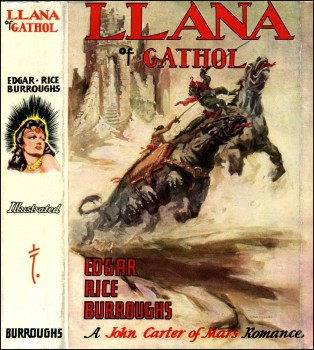 Back on Mars, and closing in on its finale, after my short sabbatical… What can I say? It seems Synthetic Men of Mars will suck out the desire to keep trudging forward from even the most dedicated ERB enthusiast.
Back on Mars, and closing in on its finale, after my short sabbatical… What can I say? It seems Synthetic Men of Mars will suck out the desire to keep trudging forward from even the most dedicated ERB enthusiast.
Llana of Gathol is the first of the two story collections that close out the published Barsoom epic: it contains four novellas chronologically linked together to produce an episodic novel… one that hopefully improves upon the failed previous book.
Our Saga: The adventures of Earthman John Carter, his progeny, and sundry other natives and visitors, on the planet Mars, known to its inhabitants as Barsoom. A dry and slowly dying world, Barsoom contains four different human civilizations, one non-human one, a scattering of science among swashbuckling, and a plethora of religions, mystery cities, and strange beasts. The series spans 1912 to 1964 with nine novels, one volume of linked novellas, and two unrelated novellas.
Today’s Installment: Llana of Gathol (1941)
Previous Installments: A Princess of Mars (1912), The Gods of Mars (1913), The Warlord of Mars (1913–14), Thuvia, Maid of Mars (1916), The Chessmen of Mars (1922), The Master Mind of Mars (1927), A Fighting Man of Mars (1930), Swords of Mars (1934–35), Synthetic Men of Mars (1938)
The Backstory
I discussed at length ERB’s decision to write novellas he could later gather into episodic novels in my review of Escape on Venus, one of the three collections he wrote simultaneously, rotating through settings. Escape on Venus was a massive bust, but part of the reason for its failure is that Venus is a minor location in ERB’s canon. The Earth’s core fared better with Savage Pellucidar. And what of Mars, so far Burroughs’s most consistent setting for quality? Could changing writing methods rescue readers from the mistakes that made Synthetic Men of Mars a glaring black mark on the series?
Llana of Gathol’s four novellas were published in 1941 in Amazing Stories: “The City of Mummies” (March), “Black Pirates of Barsoom” (June), “Yellow Men of Mars” (August), and “Invisible Men of Mars” (October). The book version first appeared in 1948 from ERB, Inc. It was the last volume of Burroughs’s work published in his lifetime.
The Barsoom series comes to an effective end with Llana of Gathol. ERB wrote one more original novella, “Skeleton Men of Jupiter,” as part of a new group of linked stories. He never wrote the others because of the outbreak of World War II and his job as a correspondent in the Pacific. The last volume of Martian stories, John Carter of Mars, wouldn’t appear until fourteen years after Burroughs’s death in 1950. The only addition to “Skeleton Men” in this volume is “John Carter and the Giant of Mars,” which was written before the Llana of Gathol stories. (And it isn’t even by Burroughs anyway, but more on that next time.)
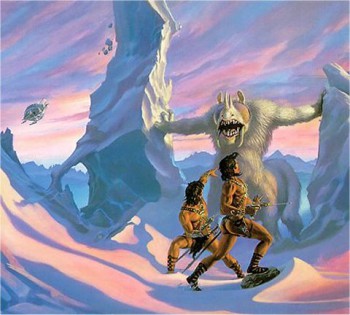 The Argument
The Argument
A prologue brings back the pseudo-ERB, now living in Hawaii like the real one. While on a beach in Oahu, he receives a visit from John Carter, who is aware his old friend and chronicler has not long to live. He tells ERB a story about Llana, his granddaughter, child of Gahan of Gathol (hero of The Chessmen of Mars) and Carter’s second daughter, Tara.
In “The City of Mummies,” John Carter takes a solitary pleasure flight to the dead city of Horz, only to find it isn’t as empty as he thought. The last descendants of the Orovars, the earliest race on Barsoom, capture him after he comes to the aid of one of the their warriors, Pan Dan Chee. The Orovars guard knowledge of their existence, and so condemn Carter and the man he rescued to death. They send him and Pan Dan Chee into the pits to await execution. In the pits, they discover a living dead hypnotist, Lum Tar O, who has placed men and women from the earliest days of Mars into hypnosis and kept them in crypts. Carter also discovers hiding in one of the sarcophagi his granddaughter, Llana. She explains that an arrogant jeddak, Hin Abtol of the northern people of Panar, kidnapped her, but she brought his flier down in Horz and took shelter in the tombs.
“The Black Pirates of Barsoom” begins with Carter, his new companion Pan Dan Chee, and Llana trekking on foot to the south to reach Gathol. Pan Dan Chee has already fallen hard for Llana (he “imprinted” onto a jetan figurine of her even before they met). A nation of the First Born, the black men of Mars, capture the trio and imprison them in the city of Kamtol. The jeddak of Kamtol records the nerve index of all the people in the city, and can kill them at any time using a hidden master machine. Carter becomes a slave-gladiator until he can find a way to destroy the machine and allow him to escape with Llana.
Carter gets back to Gathol in “Yellow Men of Mars” only to find Hin Abtool and the Panars have besieged the city, thinking Llana is inside. Carter secretly joins the Panar navy as a panthan (soldier of fortune) and seizes a ship to make an expedition to the north to retrieve Llana from the Hin Abtool’s capital. (Oh yeah, she got kidnapped again.)
The return to Gathol gets sidelined when Carter encounters “The Invisible Men of Mars”: the people of the nation of Invak, who have found a way to turn themselves invisible in the daylight. John Carter hangs around because… you guessed it… Llana got kidnapped again, and our hero has to rescue her from the jeddak of Invak and then try to get back to Gathol to lift Hin Abtool’s siege.
Eventually, John Carter dies a tragic but fitting warrior’s death before the gates of Gathol, his granddaughter’s corpse laid before him…
Actually, no. John Carter kills everyone because John Carter is friggin’ awesome and the mostest bestest warrior of like four-thousand worlds and stuff.
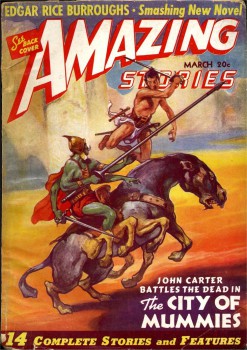 The Positives
The Positives
Llana of Gathol improves over the sorry Synthetic Men of Mars and even more so its horrible contemporary in linked-novellas, Escape on Venus. The four parts fit together in a way the Venus collection never got near. Hin Abtool serves as the throughline for the episodes; even if the plot structure still relies on repeating the identical story of Carter landing in a strange place, getting captured, and losing Llana, only to eventually rescue her, Burroughs at least tries to give each section its own flavor and give a sense of an overall progression. It’s a fast read: trivial, but much more fun than the bore of the previous book.
Despite the title, Llana is a supporting character. John Carter is back at the first-person helm. This isn’t anything I welcome, but an unusual passage at the beginning of “The City of Mummies” shows a slightly different take on the character than ERB had previously shown:
Fighting has been my profession all the life that I can recall. I fought all during the Civil War in the Confederate Army. I fought in other wars before that. I will not bore you with my autobiography. Suffice it to say that I have always been fighting. I do not know how old I am. I recall no childhood. I have always appeared to be about thirty years old. I still do. I do not know from whence I came, nor if I were born of woman as are other men. I have, so far as I know, simply always been. Perhaps I am the materialization of some long dead warrior of another age. Who knows? That might explain my ability to cross the cold, dark void of space which separates Earth from Mars. I do not know.
Whoa. John Carter has crossed into Starchild territory here. Perhaps Burroughs was trying to set up future adventures where “John Carter” becomes an idea with no need to be moored in continuity. He did something similar with the final Tarzan novel, Tarzan and “The Foreign Legion”, where Tarzan has apparently become immortal and no longer seems to have any history.
“Yellow Men of Mars” is the most exciting of the four parts. It’s a mini-naval adventure with Carter as the captain of a seized ship. Burroughs crams in plenty of interesting sequences and concepts into a short space and keeps the action varied and in constant motion.
There are interesting ideas throughout Llana of Gathol: the living-dead culture of Horz, the unusual take on invisibility in Invak, Hin Abtool’s freeze-dried soldiers, and especially the nerve-killing machine of Panar. Any one of these might have sustained the core of a novel. The invisible men end up working the best. ERB did some real thinking on the well-worn SF trope of invisibility and pulls some pleasing tricks with it, such as making the Invaks unable to see each other as well, limiting their effectiveness as an “invisible army.” Too often in early pulp literature, authors assume that invisible people are able to see other invisible people as well, so it’s nice to see this complication.
There are many callbacks to earlier Martian novels: a return to the icy north, the reappearance of the monstrous apts that were one of the best parts of The Warlord of Mars, and cameos from old characters. Seeing Tan Hadron, hero of A Fighting Man of Mars, pop up aboard the commandeered vessel in “Yellow Men of Mars” is a great surprise — even though he ends up doing very little.
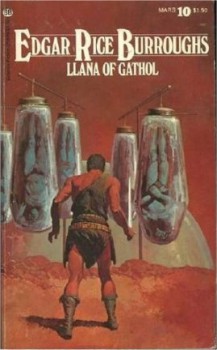 The most interesting new character is Rojas, a royal woman of Invak, who tempts John Carter with a forbidden romance (ERB heroes are not permitted to switch love interests once established), while trying to work her own agenda. The wrap-up to this is too convenient, but Rojas is the only female character with any presence, and it’s good to have her along to vary Carter’s motivations.
The most interesting new character is Rojas, a royal woman of Invak, who tempts John Carter with a forbidden romance (ERB heroes are not permitted to switch love interests once established), while trying to work her own agenda. The wrap-up to this is too convenient, but Rojas is the only female character with any presence, and it’s good to have her along to vary Carter’s motivations.
I enjoy it whenever Burroughs puts his focus on Barsoom’s lush past and the contrast with its arid and moribund present. The entombed men and women of Horz, who fell asleep during the planet’s oceanic Golden Age and woke up in its death throes, are a good embodiment of this concept. Their emergence into the changed planet and then their abrupt demise is a highlight of the book.
The Prologue features the last appearance of the fictional version of ERB who first showed up in A Princess of Mars. The short passage is poignant: Burroughs, both versions of him, is aware of his mortality, and seems to wonder if John Carter will long survive him. His own character tells him, “After you are dead, and it will not be long now, I shall have no Earthly ties — no reason to return to the scene of my former life.” The descriptions of the beach in Hawaii are lovely and soothing, adding to the sense of a serene, quiet goodbye to life. More than anything in the last two Barsoom books, this is the author’s farewell to it all.
Burroughs’s humorous side was strongest in the 1940s, and Llana of Gathol has a smattering of gems strewn through it, like this:
“You are insolent,” snapped Kam Han Tor. “You shall be punished.”
“You have been dead a million years,” said Pan Dan Chee. “You should lie down.”
And this: “I have never seen such a courteous and considerate people as the Orovars; it might almost be a pleasure to have one’s throat slit by one of them, he would be so polite about it.”
The Negatives
It may be better than Synthetic Men of Mars, but Llana of Gathol is still minor Edgar Rice Burroughs and weaker than all the books before Synthetic Men. After “The City of Mummies,” each novella uses the identical plot structure of Carter making a landing and immediately losing his granddaughter Llana to a kidnapping. Eventually, Carter gets her back from whatever jeddak lusted to marry her against her will, and then they trudge/fly off to the next adventure. Perhaps spacing out the novellas and reading them as self-contained might take the edge off this problem; absorbing all four parts at once reveals how unvarying the structure is and makes everything predictable. By the end, the reader will want to scream at the hero: “Stop landing! You’ll only get captured again!”
Llana is useless as a character, despite getting top-billing. Only during her narration of her escape from Hin Abtool in “The City of Mummies” does she remain on the page for more than a chapter. The rest of the time she’s off-page awaiting rescue. Carter doesn’t seem to care much about her either; he needs to rescue her because that’s what heroes in ERB novels do, they rescue kidnapped women. The romance between Llana and Pan Dan Chee is a non-starter, since neither character appears much after the first novella. Burroughs plugs them into the standard roles, then just leaves them to follow John Carter around as he moves through the different civilizations. Pan Dan Chee should have been the hero of the four novellas, not John Carter.
Burroughs teases a supporting cast to go along with Llana and Pan Dan Chee, but they all disappear into the background as well. This is especially frustrating with a classic character like Tan Hadron. Carter gets temporary sidekicks for each novella, and each sidekick gets kicked to the curb afterwards. It begins to feel as if we’re seeing the wrong side of the story, and it’s Carter who should have remained off stage, waiting to jump in at the end. Of course, that didn’t work well for Synthetic Men of Mars… so hows about dropping John Carter altogether, eh?
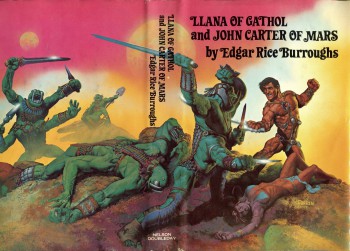 Because reverting to John Carter as hero and narrator… yawn. Outside of the original “John Carter Trilogy,” I prefer the Warlord of Mars to stay on the fringes; what worked about Swords of Mars had little to do with him as the lead. Despite that one passage giving Carter a near metaphysical aspect, he’s the same old invincible, fearless braggart as before. In fact, it seems something of the “jerk” version of Carson Napier, who was simultaneously appearing in Escape on Venus, infects John Carter; he’s actively contemptuous throughout much of the book, and his attitude toward women is no longer chivalric, but a touch intolerant. In number of places, Carter turns to the reader and basically does the old “Women, huh? Am I right fellas?” routine.
Because reverting to John Carter as hero and narrator… yawn. Outside of the original “John Carter Trilogy,” I prefer the Warlord of Mars to stay on the fringes; what worked about Swords of Mars had little to do with him as the lead. Despite that one passage giving Carter a near metaphysical aspect, he’s the same old invincible, fearless braggart as before. In fact, it seems something of the “jerk” version of Carson Napier, who was simultaneously appearing in Escape on Venus, infects John Carter; he’s actively contemptuous throughout much of the book, and his attitude toward women is no longer chivalric, but a touch intolerant. In number of places, Carter turns to the reader and basically does the old “Women, huh? Am I right fellas?” routine.
I love the nerve-killing master machine in “Black Pirates of Barsoom” — as an idea. In execution, it does nothing, and the second novella is just a boring series of gladiator fights during which John Carter never feels as if he’s in any danger. (Actually, he never seems threatened at any point in the book.) Burroughs once excelled with arena combats and duels, but here it’s tired and repetitive, filling out space until Carter abruptly solves the problem of the master machine.
The ending is a rush-job again, an unfortunate holdover from Synthetic Men of Mars. Burroughs teases Hin Abtool and the Panars as the central menace throughout the book, but when it comes to resolve this for the climax, it’s a few tensionless paragraphs that makes the Panars in retrospect almost useless as villains.
The Orovars throw off the grand history of Barsoom that was first sketched out in detail in The Gods of Mars. Wait, there’s an even older Martian race we never knew about! Not only have the Therns and the First Born already filled this niche, the Orovars don’t have the literary weight to replace them, and they’re far too pleasant and polite to be threatening. On top of that, they have annoyingly repetitive names that sound silly even on the page. (Try reading them out loud. Hilarity.) Except for Pan Dan Chee, they vanish from their own story before they can bring it to a conclusion.
This has nothing to do with Burroughs, but it’s a shame Frank Frazetta didn’t do the cover for the Book Club edition that collects this and John Carter of Mars.
Craziest Bit of Burroughsian Writing: See paragraph below.
Best Moment of Heroic Arrogance: John Carter declares that it isn’t he who is so danged awesome, it’s the even awesomer way he wields a sword! “I do not take great credit for my fighting ability, for it seems to me that my sword is inspired.”
Times a “Princess” (Female Lead) Gets Kidnapped: 4, once per novella
Best Creature: The super-ulsio (Martian rat) is the only new beast we get. Glad to have the apts back, however!
Most Imaginative Idea: The nerve-blasting master machine of Kamtol.
You’re One to Talk, John: “The lesser people of Barsoom are great braggarts; they always have the best swordsmen, the finest cities, the most outstanding culture.…”
Should ERB Have Continued the Series? No. He’s said everything he needed to say.
Next: John Carter of Mars
Ryan Harvey is one of the original bloggers for Black Gate, starting in 2008. He received the Writers of the Future Award for his short story “An Acolyte of Black Spires,” and his stories “The Sorrowless Thief” and “Stand at Dubun-Geb” are available in Black Gate online fiction. A further Ahn-Tarqa adventure, “Farewell to Tyrn”, is currently available as an e-book. Ryan lives in Los Angeles, California. Occasionally, people ask him to talk about Edgar Rice Burroughs or Godzilla in interviews.
Is it just me or does the spine illo on the hardcover dustjacket look like Wonder Woman?
Now that you mention it, yeah it does. Jack Burroughs must’ve been reading some comic books in the ’40s.
[…] Edgar Rice Burroughs’ Mars, Part 10: Llana of Gathol […]